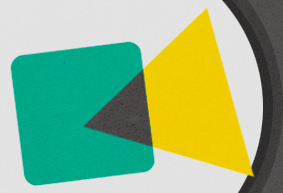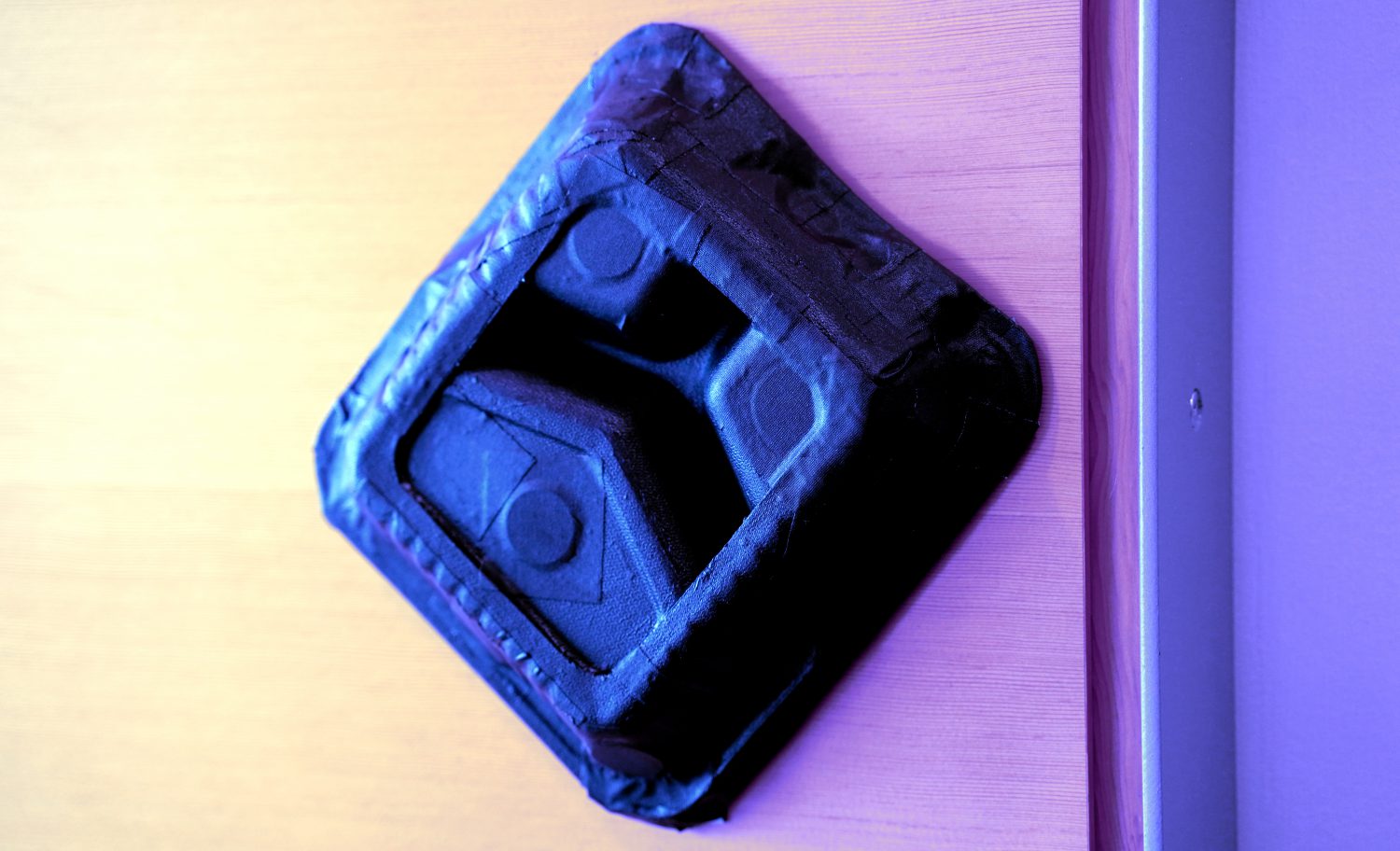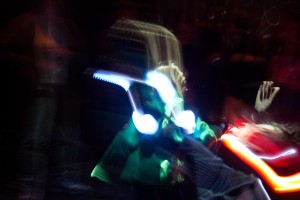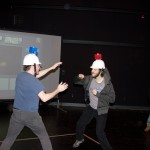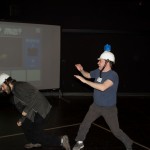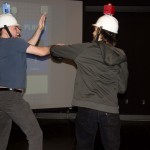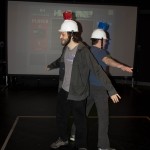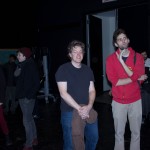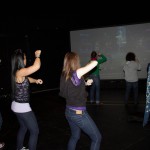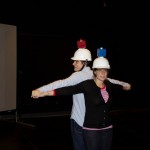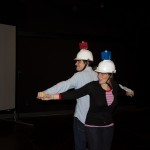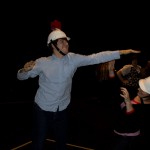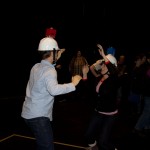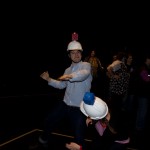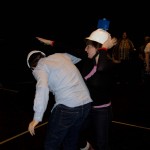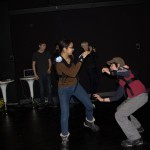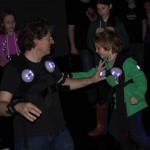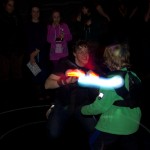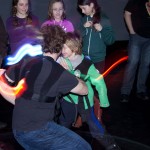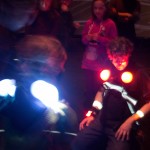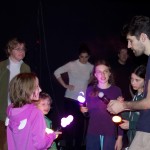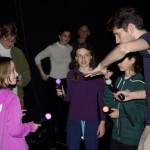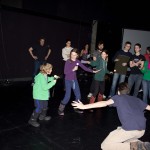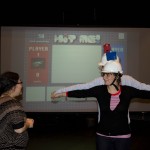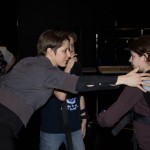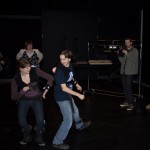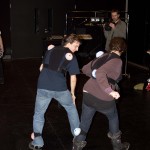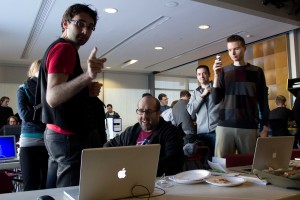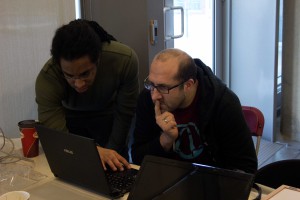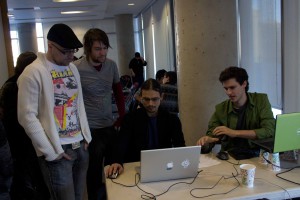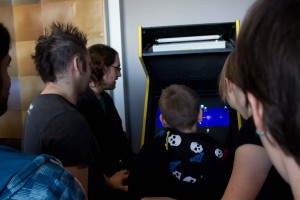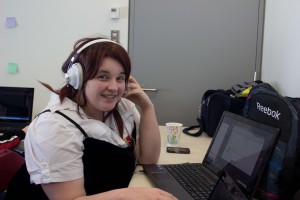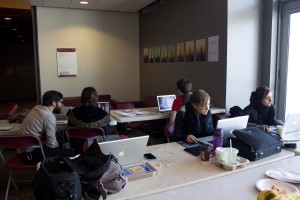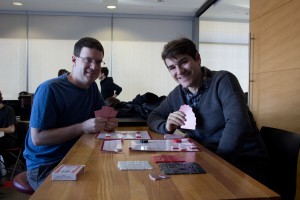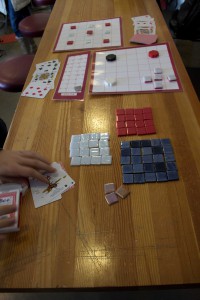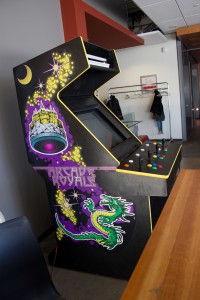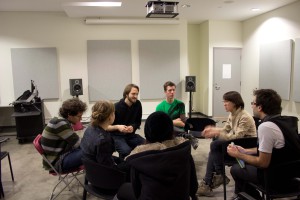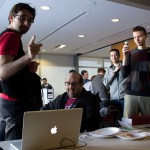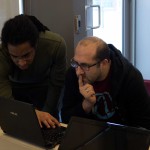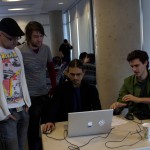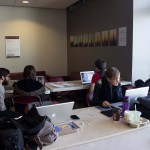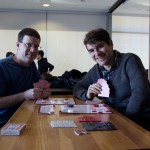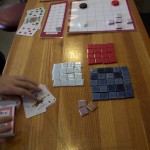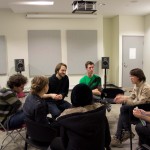This summer, TAG is hosting a game collaboratory called Critical Hit for games for social change. The program will run ten weeks and applications are open until the 29th of April. With that in mind, I spoke to Lynn Hughes, the TAG Centre’s Associate Director, and Bart Simon, the TAG Centre’s Director, about the genesis of the collaboratory and their hopes for the project. To know more about them and what they do at TAG, you can visit our people page.
JRM: When you started TAG, what was your vision for the centre? What kinds of work with games did you hope to foster, and what do you envision for TAG and its projects in the future?
LH: One of the main things was to do something with other departments and involve groups and individuals from outside of the university. We wanted to have a bigger bundle, a bigger mess.
BS: The fundamental idea of the centre was to break the deadlock of disciplinary divides. The research centre model is the best structure we have for thinking of doing that in a way that doesn’t overly burden individual faculty members. Once individual faculties members are actually able to come together and spend time together, we can make it easier for students to do so as well. That’s the real goal: not to change our lives, so much as to the conditions for graduate students and eventually undergraduate students. The idea is to create a structure which enables this kind of interdisciplinary collaboration. With respect to game design, this should have an impact on the kinds of games people think of making and on the kind of games that they actually make.
LH: The idea is not supposed to be that Bart and/or I conceive of a research idea and then a bunch of other people execute it. The idea is that projects are supposed to bubble up from wherever they bubble up from and we see if there’s a way that we can bring people together and facilitate them or support them. It’s supposed to be a lever for other things, not just for us.
BS: Literally, a kind of social-cultural material condition of possibility, right? Until we get a structure where it’s possible for students to breathe long enough that they can imagine doing something else, it’ll never happen. The idea is to make a space where people start to realize that their own education can be something other than what they expected it to be.
LH: In my case, one of the other motivations is to move out of the art sphere and into the games sphere – or more precisely to interbreed the two. That was what this was starting out – more recently, it’s been about trying to promote a view of games that is much broader than the view that you get in the media. It’s also much broader than the view that you get from some people making games. For me, TAG contains a very broad spectrum of stuff, it includes all kinds of things, some of them near art and some of them all the way on the other end of the spectrum.
BS: One of our goals is to think about games in the broader liberal arts sense rather than in the vocational game making sense. Do games have a place in the conception of what the traditional liberal arts mission of the university might be? We’re trying to reimagine what the role of liberal arts is. Rather than making new workers for this industry that may or may not survive, we have a much broader conception of what games can be.
JRM: Montreal is a fairly important city in game development today and fosters a vibrant indie developer culture. How do you think TAG benefits from the community in the city and how do you think the community benefits from TAG?
LH: At this point, we’re getting really well-connected. If you look at something like Mount Royal Games Society, two of the leader-founders are connected to Concordia.
JRM: Saleem Dabbous and Stephen Ascher.
LH: I’ve also known Nick Rudzicz for a long time, but Saleem and Stephen are specifically Concordia connections. In terms of TAG, you can see that there’s a lot of back-and-forth. Bart and I are currently trying to organize something in London and we hope to involve the Mount Royal Games Society (http://mrgs.ca/). Or, there’s the IGDA and someone like Jason Della Rocca who was the IGDA director for many years and who is now doing Execution Labs. There’s a very collegial connection – there’s a regular flow of emails and late dinners, talking and exchanging.
BS: Montreal’s game developing community is a bit different than others in part because it’s super-dense. There’s a very large number of media arts-trained people in the development community rather than pure engineering or pure computer science. When Lynn and I started, there was a natural audience, a natural community that extended beyond the University. We used to go to the Montreal Games Summit when it first started up – our students were there, participating in everything that was going on. We used to sit in cafés chatting with everyone about games. Early on, we had projects where industry designers would informally or more formally make use of students. The networks were starting to develop.
One of the crucial things is to have a platform that allows us the time to do that – a platform that says it’s good to go over to Ubisoft, it’s good to go to EA, MRGS meetings, IGDA meetings. The community is very rich: students should go, faculty should go. Out of those connections, which are informal and casual, come real collaborations, and that’s one of the only ways that they come. We’ve been lucky because of where we are in that sense. Montreal doesn’t have the vibrant indie community that other cities have but there is a density that has allowed it to continue developing. We see part of TAG’s role as participating in the building of that vibrancy, given the background of the changes in the industry.
LH: Speaking of the relation between media arts and games here, it’s been unusual. I don’t think that you’ll find that in Toronto or Vancouver the way that it is here. Concordia is a part of that, but it seems to be generally the case in Montreal. If you want to look at TAG’s relationship to that, something like FRACT would be a good example. The FRACT team came here for our first incubator and ended up completely redesigning FRACT using MAX/MSP, which is a media arts approach to doing sound – it’s not at all a games’ approach. They did that with the help of a Concordia student. That’s special to here.
I’d also like to talk about our relationship to Dawson. If we’re talking about Critical Hit, that’s an important relationship that developed somewhat naturally because Dawson is just down the road and because they’re doing similar things to us. Sean Bell from Dawson came and found us and we’ve formed a great relationship that’s very important to the Critical Hit project.
JRM: Critical Hit is described on its website as a “A Montreal-based summer program to catalyse the development of experimental games motivated by contemporary social, cultural and political concerns.” How do you feel about the way that games are currently being mobilized as vehicles for social change?
LH: That covers a broad spectrum! I wouldn’t pretend know what the whole spectrum looks like. There’s a caricature of it that I have in my head – that there’s a superficiality or that the games aren’t very good. I think that’s probably a simplification. I’m looking forward to spending the summer discovering the better games that are trying to mobilize social change. I do have a broader definition of what can be included in that category – not because I have a broader definition of social change although I may have that, but because I have a broader definition of what can be considered a game! I’m looking forward to taking a look out there some more and seeing what I find.
BS: It’s important to note that we don’t necessarily purely subscribe to the definition of serious versus unserious games or games for change versus games that are not for change. Our description of what we’re looking for is trying to get at – I believe – a kind of a level of designer intention that says ‘we believe that in contemporary culture games communicate things about the world and that you can have an idea about what you want to say about the world and do that with a game.’
I’m less concerned about what it says than that the designer would like to say something and has a conception of who they would like to say it to and what they’d like that person to hear. Part and parcel of that is that it isn’t acceptable from the point of view of Critical Hit to have a designer come and say that ‘what I would like to communicate is the need to make more money. I want to make a game that I simply know will make money’ or simply to come up with a game that’s about saying ‘I have a better shooter.’ What we’re asking is for a level of designer intentionality that I wouldn’t say is missing from the games industry but that needs development. It’s there, and people are crying out to be able to make games that communicate something about the world that they’re a part of. What we’re trying to do is open up the space without getting trapped in the definition of what counts as a good game to make.
LH: The way I would put that is to say that we want games that are thinking about games and thinking about the world. A lot of the time, there’s games thinking about games. That’s a good thing but we’d like them to be thinking about the world at the same time. And the question is, what does that mean? Because we want them to be thinking about the world in a way that’s interesting where the game is also interesting. We’d like to be surprised. Whether that will happen right away, I don’t know. Maybe this will happen over the course of the next three years. The first year is going to involve this kind of discussion. Hopefully by the second year but definitely by the third year, people should see the collaboratory as a place where they can bring unusual games or games that might not be accepted anywhere else.
BS: Medium specificity also matters. It’s not like somebody can say ‘I have an idea for a film but there’s no incubator for films so I’ll just try out my idea for Critical Hit.’ That’s not gonna work either. There’s got to be some discussion of why the medium of the game is important. We’re looking for an understanding of what games are, in terms of their mechanics and their futurity – why it matters as a game and not as a novel or a poem or a film or any other medium of cultural production.
JRM: The teams who make it into the Critical Hit collaboratory get to keep all their intellectual property and are actually encouraged to try out more experimental angles that won’t necessarily lead to commercial success. Many incubators do have the goal of commercial success in mind. How do you expect this will change the output of the incubator?
LH: It’ll be better? I don’t know – I don’t know if I think about it that way. I think that we should be looking for releasing new kinds of games. The criteria shouldn’t be whether or not they’ll be commercial successes. Maybe some of them will be commercial successes. I think that it would be ridiculous to be against commercial success.
That’s not the idea – the idea is that that’s not what we’re going to talk about. What we will be talking about is whether or not it’s a good game – and that can help with commercial success. The idea is that it should be an interesting good game.
BS: I’m not convinced that we would entertain any proposal for a game that has no intention of being played. If there’s an intention for it to be played, I think that it’s obvious to begin thinking about commercialization, or at least distribution. We’ve been pretty clear that you don’t have to plan to make a game for iOS and go through the Apple store, although you certainly can. You could instead shoot for a festival venue or something along those lines – both are equally legitimate to us. I think that the notion that one should design with players and distribution in mind is crucial. What commercial incubators are struggling with, is that failure is crucial to innovation. But if you have a business model incubator, your window for failure is much narrower than I would argue ours is. We’re not going to live or die on the basis of the success of the games in our incubator.
What we’re going to encourage is experimentation, innovation, failure – in a productive way, and therefore hopefully affect the broader landscape. It’s not just about us, but about how the games that we’re making in our incubator can actually impact the larger community. How can the games that are made and the process by which we make them in our space influence how people make games in the industry, or in other incubators, or at jams? This tiny little three-year experiment is to see whether our context – a non-commercial context for game incubation – makes sense and to join a larger conversation about game-making.
LH: This is also partly about how universities can work with an industry or the larger community – about what the relationship is between inside the university and outside of the university. The idea in the university is “excellence!” How does excellence translate into commercial success? I think that it should. It’s just that the emphasis here is on taking risks, on innovation, on excellence in a broad, non-stuffy way of thinking about it, and what happens after that.
BS: At the same time, we’re going to encourage excellence, say, through failure or experimentation. But we’re not encouraging flakiness. The idea is not to come in and slack off because the pressure of commercial success is off and you’re not hungry for dollars to survive. We think we can give people the experience of what it’s actually like to make a game under serious conditions while at the same time protecting them from the survival worries that plague commercial incubators.
LH: We’re planning on doing more than one public presentation at the end – that in itself is a deadline. A serious deadline: you have to get up there and make a fool of yourself or show what you’ve done.
JRM: Ideally, at that point, you’re proud of what you’ve done because you’ve been taking the work seriously.
LH: Yes, so that you’re not ashamed to get up there and say what you’ve done.
JRM: What kinds of games are you hoping to see come out of the Collaboratory?
LH: I’m hoping that I’ll see something I didn’t expect! Something exciting, something new.
BS: I’m hoping that we’ll see something different, that we wouldn’t have anticipated we’d see. I’m also hoping we see something ambitious. I’d like to see teams that aren’t interesting in settling, even if that means going beyond the scope of our ten-week project. I’m also interested in seeing what the process itself brings to the team. It would be pretty sad if a team came in with a plan, executed the plan and it was exactly what they planned on doing from the beginning. That wouldn’t say much about the productive space that we’re trying to create.
JRM: It also doesn’t fit how any project ever actually ends up working.
BS & LH: Yes!
LH: If that’s the case, there’s something wrong.
BS: What we need to think about in order to keep this project going is how our process influences exactly those changes that takes place. The outcomes are games, yes, but they’re also processes, and how to understand the process is equally important to us.
JRM: Has TAG been involved in other incubator-style projects? What kind of work came out of them?
LH: Two years ago, we did the first Montreal Games Incubator and we had four projects. One of them was FRACT. We had one large team that came mostly from Dawson, one from Champlain College, one team of independent professionals and one one-person team. The games were all quite different. The whole experience was really a success. The larger team especially told us that they got a lot out of the mentorship.
BS: Our first pilot was just to see if we could run an incubator. We asked people who already had a project and let them make their games.
LH: We had a call just like this one, and about ten teams submitted, out of which we chose four teams.
BS: “CUBE” was the Champlain College iOS 3D puzzle game. “Commander” was from a UdeM one-person team who was looking to improve an already-released game. The big team from Dawson made “Damnatus” which was an online multiplayer tower defense game… we knew that it would have to be cut down. It was a good process to see how the team pared down the project with the help of the mentors and the other teams. “FRACT” came in already having won the student competition at IGF.
Richard Flanegan, the lead designer, already had a good idea of what he wanted to do, and came into the incubator and completely changed his mind because of experiences he had at the incubator. That was a really strange proof-positive that we had something interesting on our hands. We thought that FRACT would be the one game that came out of the ten-week incubator looking ready to go, but it turned out to be the one that got redesigned from scratch, but also as a result is the most robust of the projects. If our incubator space allows for that robustness to develop, then the results should be promising.
LH: We also had a nice presentation night for the games where each team came up and gave a short presentation about their game, after which we had a big party with demos up. Lots of people came and it went very well. We were pleased, especially for something that we just leapt into and crossed our fingers, because we wanted to see what would happen.
BS: Since then, we’ve also done the Global Game Jam two years running and a lot of TAG people got involved with the Pixelles incubator. We’ve been very closely watching Jason Della Rocca’s XL and we were involved in early conversations about what it would look like. We’ve been focusing on game incubation activities since the pilot.
JRM: Is there anything else that you’d like to say about the incubator or the projects going on at TAG?
BS: It’s important for me to understand the Critical Hit project as part of a larger ecosystem. While one of the motivations for Critical Hit is a kind of conversion of space and resources in the summer time – students are off and doing their thing – how can we keep the game developing going 24/7? At the same time, it’s not like we just cycle in and cycle out when the students return. We’re developing relationships and hope to foster collaborations during the rest of the year between students, indie developers, other universities, mainstream industry people and community arts people. The longterm hope is that we’re seeding a major Montreal establishment. In the next five years, we hope to have a vibrant hub – publicly supported and funded – for people to get together and make games. Less than a business incubator and more than a game jam – that’s how I’ve come to think about it.
LH: In terms of community ties, we’re especially happy to be fostering Angelique Mannella and the Decode Global team. Decode Global is an independent not-for-profit company and they’re winning all sorts of awards for their new game, Get Water! We lent them space and have been supporting them, nurturing a relationship with with the outside world under our roof. Also, since Angelique is now going to be managing Critical Hit, we hope that there will be an interesting synergy there. We want to blur the boundaries – or make them permeable – between what’s inside the university and what’s outside.
—
